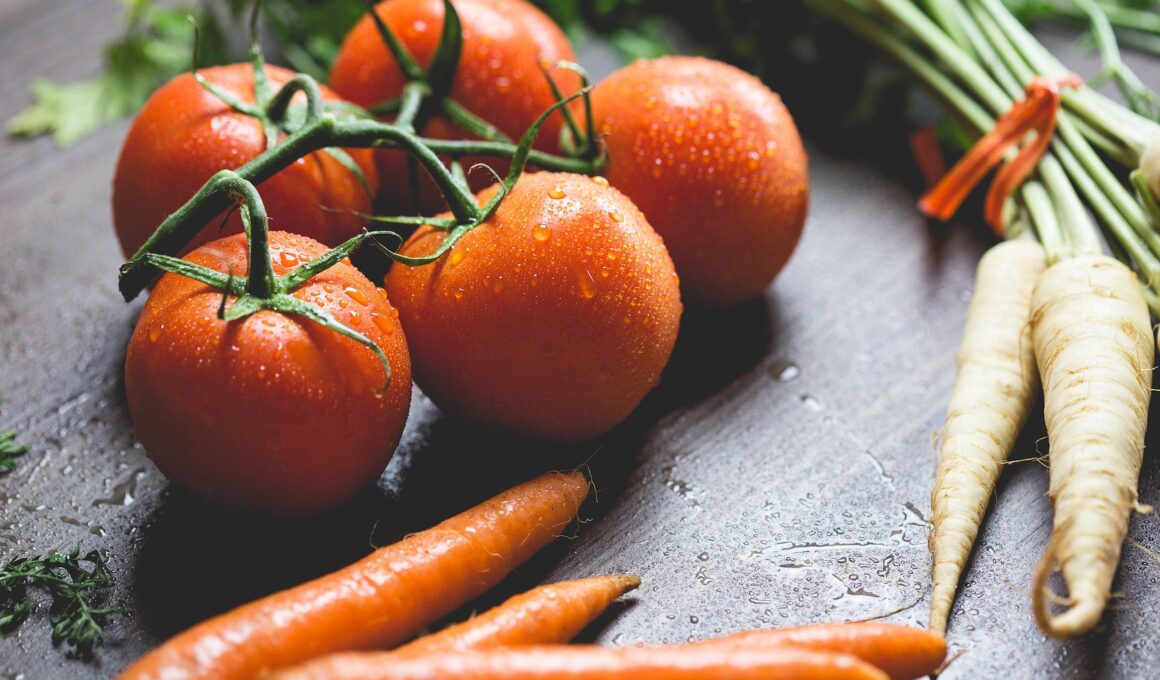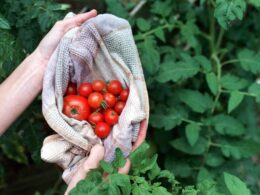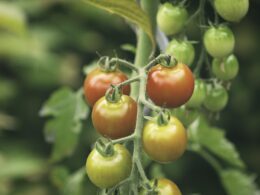Growing tomatoes is a rewarding experience that can provide you with delicious, juicy fruits. But to ensure the best harvest, it’s important to get the soil right.
Knowing what makes the perfect soil mixture for tomatoes can help you create a thriving garden full of healthy plants and delicious fruit.
In this article, we’ll look at how to craft an ideal soil mix for your tomato plants and why it’s so important.
So let’s get started!
Understand the Basics of Soil Mixtures
You can create the perfect environment for your plants by understanding the basics of soil mixtures! The key components to a healthy mixture are compost, organic matter, and growing cover crops.
Compost is decomposed organic matter that adds essential nutrients to the soil. It helps increase water retention and boosts microbial activity in your soil. Organic matter like leaves, straw, or grass clippings also helps improve fertility and structure while providing important microorganisms with food.
Growing cover crops helps prevent weeds from taking over your garden while increasing nitrogen levels naturally in the soil. An ideal tomato plant prefers well-drained soils with plenty of organic material and slightly acidic pH levels between 6.0-7.0.
You may need to use a combination of ingredients such as gypsum, peat moss, sand, vermiculite, perlite or manure to get the desired consistency for your soil mix if it doesn’t already have these elements present naturally in it. The best way to ensure that your tomatoes thrive is to maintain balanced nutrient levels in soil throughout their growth period by fertilizing regularly and adding compost periodically or mulching around plants with an organic material like grass clippings or straw at least twice a year.
Choose the Right Soil
Choosing the appropriate soil is essential for cultivating tomatoes to their fullest potential. The best soil combination should be a mix of organic matter, such as compost and manure, and inorganic matter like sand or perlite. This mixture allows for a good balance of air, water, and nutrient retention.
Microorganisms in the soil are also important. They help to break down organic material into nutrients that can be absorbed by plants. In addition, having a balanced pH level is beneficial; this ensures that the tomato plants have access to all of the available nutrients in the soil mixture.
When selecting a soil mixture for tomatoes it’s important to keep in mind how much drainage it has; too much could lead to root rot while too little will result in waterlogged roots. It’s also essential to ensure that it has enough organic matter for nutrient availability and microorganism activity.
Finally, monitoring both the pH levels and nutrient content of the mixture is key for providing tomatoes with what they need to grow healthy fruits throughout their life cycle.
Finding the perfect balance between air circulation, water absorption, nutrient supply, microorganisms, and pH levels takes some trial-and-error but when done correctly it can create an ideal growing environment that supports strong yields of delicious tomatoes season after season!
Add Nutrients
To ensure your tomato plants have all the nutrients they need for a healthy life cycle, supplement the soil with fertilizer. Fertilizing strategies should be tailored to the specific nutrient needs of tomatoes, such as nitrogen, phosphorus, and potassium. Trace minerals, like magnesium and calcium, can also help strengthen tomato plants against disease and pests.
To make sure that your soil has enough of these essential nutrients, fertilize it regularly. Organic or chemical fertilizers can both be used on tomato plants – whichever you choose depends on what works best in your garden. For organic fertilizer options, consider composting materials like manure or kitchen scraps that are rich in nitrogen and other plant-friendly compounds.
Chemical fertilizers are formulated with specific ratios of essential nutrients suitable for tomatoes and other vegetables. However, they must be applied carefully to avoid over-fertilization, which can damage plant roots. When applying any type of fertilizer to your tomato plants, water thoroughly after application to help spread the nutrients into the soil and make them available for absorption by the plant’s roots.
With adequate fertilizing strategies in place, you’ll ensure that your tomatoes receive all the necessary nutrition to grow strong and healthy throughout their life cycle!
Test for pH Level
Checking your soil’s pH level is crucial for a successful tomato harvest – don’t miss this step! Tomatoes need slightly acidic soil to thrive, and the pH level measures the acidity or alkalinity of your soil. You can purchase an inexpensive soil test kit at most garden centers or home improvement stores, and you should perform the test before planting your tomatoes.
Here are some tips for testing your soil’s pH level:
- First, water the soil around your tomato plants thoroughly with neutral tap water.
- Next, take several samples from different parts of your garden using a trowel or spade.
- Finally, mix equal parts of each sample in a bucket and add distilled water according to the instructions on the package of test strips.
The type and amount of fertilizer you use also affects the overall health of your tomato plants. For best results, choose organic fertilizers like fish emulsion or seaweed extract instead of chemical fertilizers, which can damage delicate plant roots and burn new shoots if over-applied. Watering techniques are important too. Deep but infrequent watering encourages strong root growth, helping tomatoes withstand disease and environmental stressors better than shallow daily watering.
What Other Soil Amendments Are Beneficial for Tomato Plants?
Healthy soil for tomato plants is crucial for their overall growth and productivity. Apart from basic fertilizers, several soil amendments can provide additional benefits. Organic matter like compost or manure enhances soil fertility, while vermiculite or perlite improves drainage. Adding bone meal or fish emulsion supplies calcium or phosphorus, respectively. Epsom salt provides magnesium, aiding in chlorophyll production. Incorporating these soil amendments helps create optimal conditions for healthy tomato plants.
Add Amendments for Drainage
Improve the drainage of your soil and give your tomato plants a fighting chance with amendments like perlite or vermiculite. Adding these amendments will help aerate the soil, which can be beneficial in promoting root development and increasing water absorption.
Composting methods can also help improve the drainage of your soil. Consider adding composted organic material such as manure, grass clippings, or straw to increase drainage while maintaining moisture levels in the soil.
Additionally, make sure you’re using proper watering techniques to ensure you don’t overwater your tomatoes and cause too much drainage from excess water. You may need to invest in a moisture meter so you can better gauge how much water is needed for healthy plant growth.
Allowing enough time for water to drain after each irrigation and avoiding planting in heavy clay soils are additional strategies that can be utilized when attempting to achieve ideal drainage conditions for tomatoes.
By taking these steps, you’ll be giving your tomato plants optimal growing conditions for a successful harvest come tomato season!
Create the Perfect Mixture
Creating the perfect mixture for planting tomatoes begins with blending soil and amendments. Before you begin, think about what type of soil you’re using so you can determine what type of amendments to add.
To create the best environment for your tomatoes, mix the soil and amendments together until they are combined evenly.
Preparing the soil this way ensures that your tomato plants will get all the necessary nutrients to thrive.
Blending soil and amendments
Mixing different ingredients together carefully can help create the perfect environment for growing healthy tomatoes. Creating the right blend of soil and amendments is a critical step in achieving this goal.
To ensure success, it’s important to mix organic compost with soil appropriate for your specific type of garden. This will provide essential nutrients and improve the texture of the soil, which leads to healthier root growth and better yields from your tomato plants.
When adding amendments to your soil mixture, be sure to use quality products that are designed specifically for vegetables like tomatoes. Depending on what region you live in or what type of soil you have available, different ratios may be necessary, so it’s best to consult an expert if you have any questions about how much amendment should be added into your mix.
With the right combination of soil and amendments, you’ll be rewarded with healthy tomato plants that produce delicious fruits!
Preparing the soil for planting
Now that you’ve blended the soil and amendments, it’s time to prepare the soil for planting.
Transplanting tomatoes into your garden can be a rewarding experience; however, there are several steps you must take before you can do so.
First, make sure your compost is ready for use by following proper composting methods. This will help ensure that your tomatoes receive the nutrients they need.
Additionally, when transplanting your tomatoes, follow these tips: water the plants thoroughly before and after transplanting them and dig holes that are twice as wide as the pots they were grown in.
Finally, add some of your prepared compost to each hole before planting. Taking these steps will ensure that your tomato plants get established quickly and produce an abundant harvest.
Frequently Asked Questions
What type of soil is best for tomatoes?
When planting tomatoes, it’s important to consider the type of soil you’re using. Amending the soil with organic matter will improve drainage and aeration, allowing your tomato plants to thrive. Additionally, adjusting the soil acidity is essential for providing optimum nutrition for tomatoes.
A good rule of thumb is to aim for a pH level between 6.2 and 6.8. This range allows for maximum nutrient uptake from the soil while also making sure that essential micronutrients are accessible to your tomato plants.
For best results, experiment with different types of organic materials until you find one that works well in your garden!
How often should I mix the soil for tomatoes?
Container gardening is a great way to grow tomatoes, but it’s important to make sure you mix the soil the right way.
To ensure your tomato plants get all of the nutrients they need, and that the soil drains properly, you should mix the soil every 4-6 weeks.
Make sure to use a combination of potting soil, compost, and perlite for optimal drainage.
Mixing in these elements will keep your tomato plants healthy and happy!
How much sunlight do tomatoes need?
Tomatoes need plenty of sunlight to grow and produce the best quality fruit. The quality of the soil also matters, so use a good potting mix or soil mixture containing compost, peat moss, perlite, and vermiculite for optimal tomato growth.
Aim for 6-8 hours of direct sunlight each day, and make sure your tomato plants get enough water to prevent wilting during hot days. The right combination of sun and soil will ensure that your tomatoes are as delicious as possible!
How much water do tomatoes need?
Tomatoes require regular watering to keep them healthy and productive, but the amount of water they need depends on factors such as soil type, climate, and nutrient requirements. Generally, tomatoes should be watered deeply once or twice a week. On hot days, more frequent watering may be necessary.
To ensure your tomato plants get enough water without over-watering, use sources like rain barrels and drip irrigation systems. These methods can provide steady amounts of moisture while conserving water resources.
What type of fertilizers are best for tomatoes?
You want to ensure that your tomatoes have the best soil possible for optimal growth. For this, you should use a fertilizer that’s designed for tomatoes and will help maintain an ideal pH balance in the soil.
Additionally, adding composting soil to your mixture can be beneficial as it provides additional nutrients such as nitrogen and phosphorus. With the right combination of fertilizers and soil mixtures, you can ensure that your tomatoes get what they need to successfully thrive!
Conclusion
Creating the perfect soil mixture for tomatoes can seem overwhelming, but it doesn’t have to be. All you need to do is get the right mix of soil, nutrients, and amendments for drainage.
Once you’ve done that, test your pH level and make any necessary adjustments. You’ll be growing delicious tomatoes in no time!
With a little patience and knowledge, creating a tailored soil mixture is an achievable goal. So don’t let it intimidate you; just take it one step at a time and soon enough you’ll have the perfect environment for growing luscious tomatoes!









